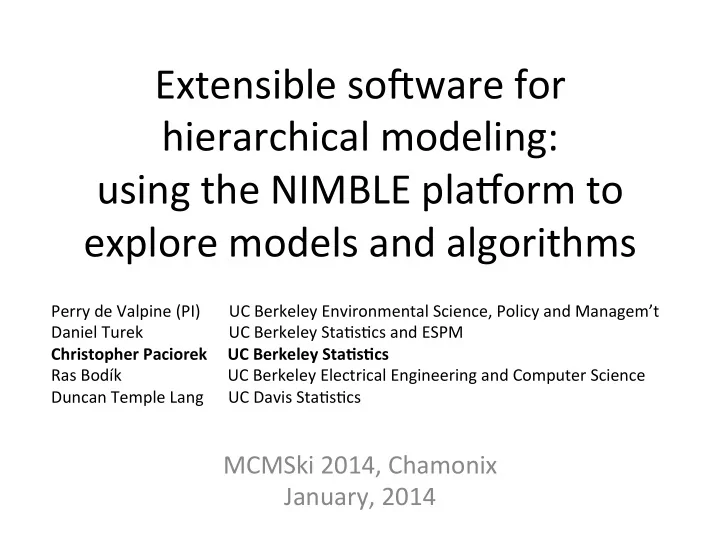

Extensible so,ware for hierarchical modeling: using the NIMBLE pla>orm to explore models and algorithms Perry de Valpine (PI) UC Berkeley Environmental Science, Policy and Managem’t Daniel Turek UC Berkeley StaRsRcs and ESPM Christopher Paciorek UC Berkeley Sta4s4cs Ras Bodík UC Berkeley Electrical Engineering and Computer Science Duncan Temple Lang UC Davis StaRsRcs MCMSki 2014, Chamonix January, 2014
Background and Goals • So,ware for fiWng Bayesian models has opened their use to a wide variety of communiRes • Most so,ware for fiWng hierarchical models is either model‐specific or algorithm‐specific • So,ware is o,en a black box and hard to extend • Our goal is to divorce model specificaRon from algorithm, while – Retaining BUGS compaRbility – Providing a variety of standard algorithms – Allowing developers to add new algorithms (including modular combinaRon of algorithms) – Allowing users to operate within R – Providing speed via compilaRon to C++, with R wrappers NIMBLE: extensible so,ware for 2 hierarchical models
Divorcing Model SpecificaRon from Algorithm MCMC Flavor 1 Your new method Y(1) Y(2) Y(3) MCMC Flavor 2 Data cloning X(1) X(2) X(3) ParRcle Filter MCEM Quadrature Importance Sampler Unscented KF NIMBLE: extensible so,ware for 3 hierarchical models
NIMBLE Design • High‐level processing in R (as much as possible) • Process BUGS language for declaring models (with some extensions) • Process model structure (node dependencies, conjugate relaRonships, etc.) • Generate and customize algorithm specificaRons • Generate model‐specific C++ code to be compiled on the fly • Provide matching implementaRon in R for prototyping / debugging / tesRng • Some high‐level algorithm control possible in R (adapRng tuning parameters, monitoring convergence, high levels of iteraRon) • Low‐level processing in C++ • Model and algorithm computaRons • “Run‐Rme” parameters allow some modificaRon of behavior without recompiling NIMBLE: extensible so,ware for 4 hierarchical models
User Experience: Processing a BUGS Model likersModelCode <‐ quote({ y[2] for(j in 1:G) { y[1] y[3] for(I in 1:N) { r[i, j] ~ dbin(p[i, j], n[i, j]); muBlock[1] p[i, j] ~ dbeta(a[j], b[j]); } y[6] mu[j] <‐ a[j]/(a[j] + b[j]); mu theta[j] <‐ 1.0/(a[j] + b[j]); muBlock[2] y[9] a[j] ~ dgamma(1, 0.001); y[4] muBlock[3] b[j] ~ dgamma(1, 0.001); }) y[8] y[5] y[7] Parse and process BUGS code (R 1 parse() ). Collect informaRon in model object. Use igraph plot method. > likersModel <‐ BUGSmodel(likersModelCode, setupData = list(N = 16, G = 2, n = data)) Provides variables and funcRons for algorithms to use. NIMBLE: extensible so,ware for 5 hierarchical models
User Experience: Specializing an Algorithm to a Model likersModelCode <‐ quote({ updater.RW.Normal <‐ nimbleFuncRon( for(j in 1:G) { …. for(I in 1:N) { origValue <‐ model[[targetNode]] r[i, j] ~ dbin(p[i, j], n[i, j]); logProbCurrent <‐ getLogProb(model, calcNodes) p[i, j] ~ dbeta(a[j], b[j]); propValue <‐ rnorm(1, mean = origValue, sd = scale) } model[[targetNode]] <‐ propValue mu[j] <‐ a[j]/(a[j] + b[j]); logProbProposed <‐ calculate(model, calcNodes) theta[j] <‐ 1.0/(a[j] + b[j]); logProbProposal <‐ dnorm(propValue, mean = origValue, sd = scale, a[j] ~ dgamma(1, 0.001); log = TRUE) b[j] ~ dgamma(1, 0.001); … }) > likersMCMCspec <‐ MCMCspec(likersModel, adaptInterval = 100) > getUpdaters(likersMCMCspec) Updater for nodes: b[1] type: RW rwInfo (list): ‐‐> 'scale' (numeric): 0.1 ‐‐> 'adapt' (logical): TRUE ‐‐> 'propCov' (character): idenRty [...snip...] > addUpdater(likersMCMCspec, updater(c(‘a[1]’, ‘b[1]’), ‘Rwblock’, rwInfo = list(scale = 0.1)) > addMonitor(likersMCMCspec, ‘a’); addMonitor(likersMCMCspec, ‘b’) > likersMCMC <‐ buildMCMC(likersMCMCspec) > likersMCMC_Cpp <‐ compileNIMBLE(likersModel, likersMCMC) > likersMCMC_Cpp$likersMCMC(20000) NIMBLE: extensible so,ware for 6 hierarchical models
User Experience: Specializing an Algorithm to a Model (2) likersModelCode <‐ quote({ buildMCEM <‐ nimbleFuncRon( for(j in 1:G) { while(runRme(converged == 0)) { for(I in 1:N) { …. r[i, j] ~ dbin(p[i, j], n[i, j]); calculate(model, paramDepDetermNodes) p[i, j] ~ dbeta(a[j], b[j]); mcmcFun(mcmc.its, iniRalize = FALSE) } currentParamVals[1:nParamNodes] <‐ getValues(model,paramNodes) mu[j] <‐ a[j]/(a[j] + b[j]); op <‐ opRm(currentParamVals, objFun, maximum = TRUE) theta[j] <‐ 1.0/(a[j] + b[j]); newParamVals <‐ op$maximum a[j] ~ dgamma(1, 0.001); ….. b[j] ~ dgamma(1, 0.001); }) > likersMCEM <‐ buildMCEM(likersModel, paramNodes = c(‘a’, ‘b’), latentNodes = ‘p’) > likersMCEM_Cpp <‐ compileNIMBLE(likersModel, likersMCEM) > set.seed(0) > likersMCEM_Cpp$likersMCEM(init = c(1000, 10, 100, 1), mcmcIts = 1000, tol = 1e‐6) Modularity: One can plug any MCMC sampler into the MCEM, with user control of the sampling strategy, in place of the default MCMC. NIMBLE: extensible so,ware for 7 hierarchical models
Programmer Experience: NIMBLE Algorithm DSL • BUGS is a Domain‐Specific Language (DSL) for models • NIMBLE provides a DSL for algorithms • The DSL is a modified subset of R. • We provide • Basic types (double, boolean) • Basic (vectorized) math and distribuRon/probability calculaRons • Basic data storage classes (“modelValues”) • Control structures – for loops and if‐then‐else • FuncRons • Linear algebra (via the Eigen package) • FuncRon definiRons in the DSL include code for two steps: • A general funcRon is wriken for any model structure • When a model is provided, a set of one‐Rme (compile‐Rme) processing is executed based on the model structure • Run‐Rme code can use informaRon determined from the compile‐Rme processing • Compile‐Rme processing is executed in R. Run‐Rme processing can be compiled to C++ NIMBLE: extensible so,ware for 8 hierarchical models
Programmer Experience: CreaRng an Algorithm myAlgorithmGenerator <‐ nimbleFuncRon ( compileArgs = list(model, …), runTimeArgs = list(…), setupCode = { # code that does the specializaRon of algorithm to model 5 secRons to a }, NIMBLE funcRon. runTimeCode = { # code that carries out the generic algorithm }, returnType = double() )
Recommend
More recommend